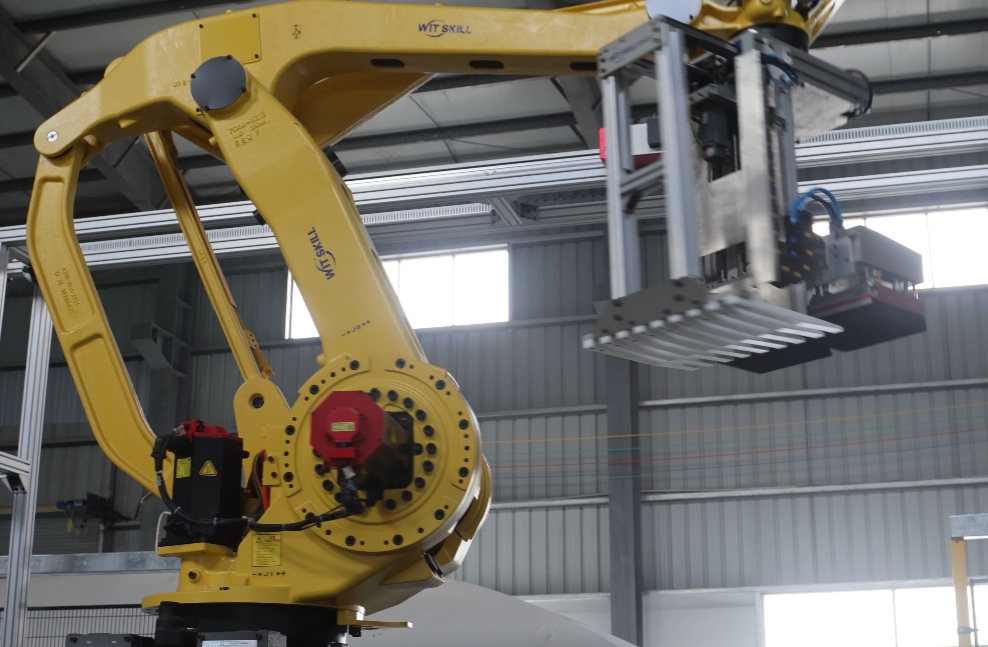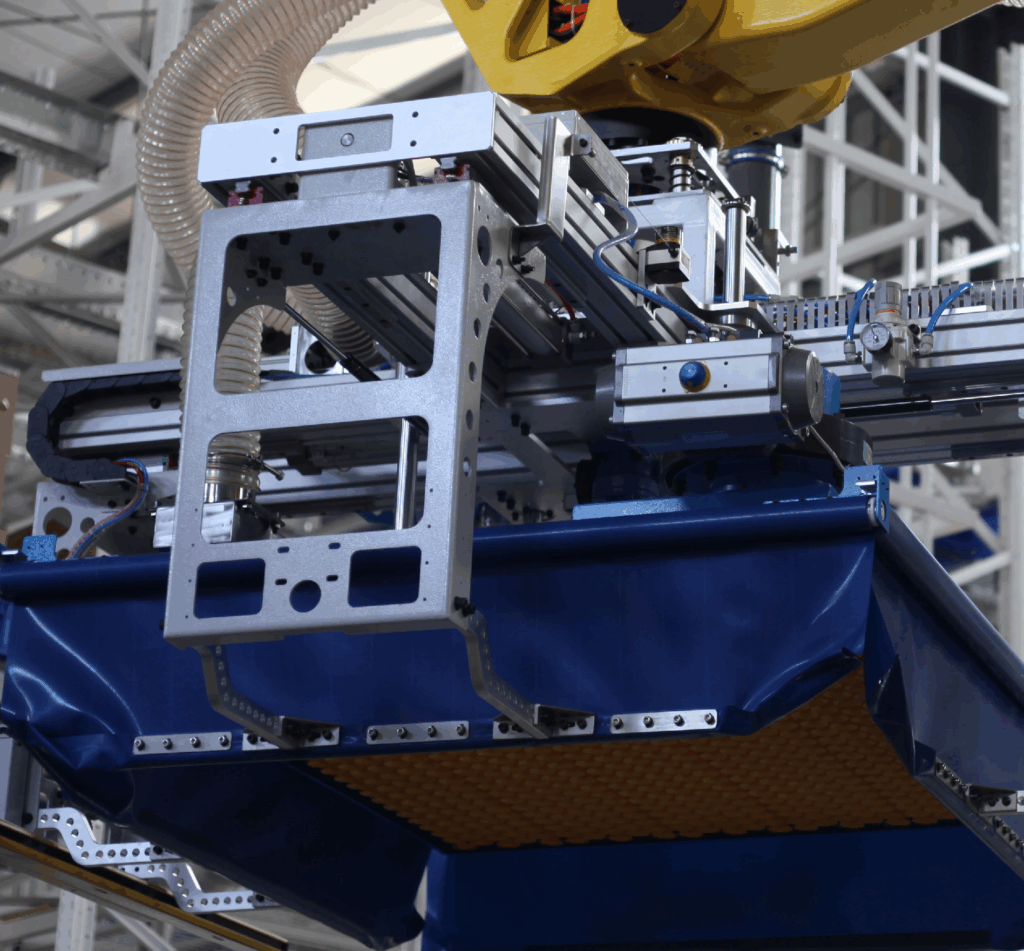In industrial automated production lines, the “hand” of a robotic arm — the End-of-Arm Tooling (EOAT) — is like a human palm, determining the efficiency and precision of material handling. From food packaging to automobile manufacturing, the selection of grippers in different scenarios holds hidden insights. Today, we’ll break down how to choose the right “mechanical palm” based on factors such as product characteristics, weight, and environment, doubling the efficiency of your production line!
I. Core Elements for Choosing the Right End Effector: Three Dimensions Are Indispensable

1. The “Personality” of the Grasped Product
What products is your production line handling? Are they loose bundles, large-sized cartons, or uneven pallets? The diversity of packaging forms complicates selection:
- Material differences: Materials such as plastic, cartons, and woven bags have distinct physical properties and surface attributes, which determine the choice of grasping method.
- Morphological characteristics: Fragile items require buffer designs, while irregularly shaped parts may need custom fixtures.
2. Product Weight: Excessive “Grip Strength” Will “Pinch” the Product
Product weight is a key indicator for measuring the load-bearing capacity of a gripper. Choosing the wrong type of fixture not only affects grasping efficiency but may also directly cause material damage or safety accidents:
- Lightweight products (e.g., cartons, plastic packaging boxes): Vacuum suction is a common and effective grasping method, which is less likely to cause pinch marks or scratches on the product surface.
- Heavy goods (e.g., metal parts, large mechanical equipment components): Custom high-strength clamps are commonly used to ensure a stable grip without falling off.
3. Customization vs. Standardization: Balancing Cost-Effectiveness and Efficiency
Customization can accurately match production line needs, with specialized designs tailored to the product’s special shape, size, and production process, thereby maximizing production efficiency and product quality. Its limitations: Costs are usually higher, and the production cycle is longer.
Standardization has advantages such as strong versatility, low cost, and short delivery cycles. Its limitation: For some special products or complex processes, it may not provide the optimal grasping effect, affecting production efficiency and product quality to a certain extent.
Standardization has advantages such as strong versatility, low cost, and short delivery cycles. Its limitation: For some special products or complex processes, it may not provide the optimal grasping effect, affecting production efficiency and product quality to a certain extent.
II. A Comprehensive Analysis of Mainstream Gripper Types: There’s Always One for Your Production Line
1. Vacuum Grippers: Versatile Tools for Flexible Handling

Application scenarios: In the food packaging industry, vacuum grippers can gently grasp soft-packaged snack bags and bread bags, avoiding damage to the packaging; in e-commerce logistics warehouses, their high tolerance for positioning errors allows quick and accurate grasping of cartons of varying specifications, enabling efficient sorting and palletizing. For example, in a large e-commerce logistics center, the automated sorting line using vacuum grippers can handle thousands of packages per hour, significantly improving logistics efficiency.
Working principle: Vacuum grippers use a vacuum generator or pump to create a negative pressure difference between the suction cup and the surface of the grasped object, firmly adsorbing the object by atmospheric pressure. Their structure mainly includes suction cups, vacuum pipelines, vacuum generators (or pumps), and related control valves. Suction cups are made of various materials, commonly nitrile rubber and silicone, with different materials suitable for different working environments and grasped objects.
Advantages:
- Compatible with a variety of products and has high tolerance for positioning errors;
- Minimal damage to the surface of the grasped object, which is crucial in industries with strict requirements for product appearance.
Considerations:
- Vulnerable to dusty environments and requires regular maintenance;
- Relies on compressed air, so energy consumption costs need to be considered.
2. Clamp-Type Grippers: Powerhouses for Heavy Load Handling

Application scenarios: When handling heavy items such as flour bags, cement bags, and woven bags of sand and gravel, clamp-type grippers can easily cope with their strong gripping force.
Working principle: Clamp-type grippers drive the opening and closing of clamps through driving devices such as motors, cylinders, or hydraulic cylinders to grasp and release objects. Their clamp parts are usually made of high-strength steel to withstand large gripping forces.
Advantages: Strong gripping force, suitable for heavy materials; high grasping precision, enabling accurate placement of goods in designated positions.
Disadvantages: Higher maintenance costs than vacuum grippers, mainly due to wear on driving devices and clamps.
3. Servo Electric Grippers: Intelligent Players in Clean Rooms
Working principle: Servo electric grippers adopt advanced motor drive technology, achieving precise control of grasping actions through accurate controllers. At the same time, built-in sensors can real-time detect the grasping status, such as the magnitude of gripping force and whether the object is properly grasped, and feed the data back to the control system for timely adjustment of grasping actions.
Application scenarios: Compared with traditional pneumatic grippers, they do not require air pipe connections, avoiding pollution to the clean environment caused by problems such as air pipe leakage and water accumulation. When grasping food raw materials or finished products, servo electric grippers can ensure a clean production environment; in pharmaceutical production workshops, their high precision and non-polluting characteristics meet strict production requirements for handling pharmaceutical packaging.
4. Finger-Type Grippers: Gentle Grippers for Fragile Items
Working principle and structure: Finger-type grippers simulate the human hand’s grasping method, usually consisting of multiple independently moving finger-like structures. These structures are driven by motors, cylinders, or hydraulic cylinders, enabling flexible opening/closing, extension/retraction, and rotation in three-dimensional space.
Application scenarios: Fragile items such as glass products and precision instruments that require additional support. The unique multi-finger collaborative grasping design of finger-type grippers allows them to fully wrap and grasp irregularly shaped, fragile, or deformable items, providing stable support and clamping.
Conclusion
Although small in size, the end effector is the “nerve ending” of production line automation. Choosing the wrong tool may lead to low efficiency and product loss, while choosing the right one can make the robotic arm more powerful. If your production line is facing grasping problems, you can check against the types mentioned in this article or contact “WIT-SKILL” — we will customize a solution for you. After all, the most suitable “mechanical palm” is the best one!